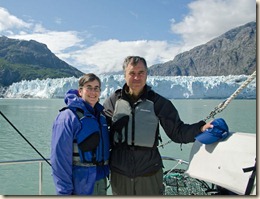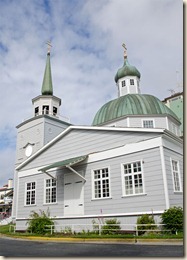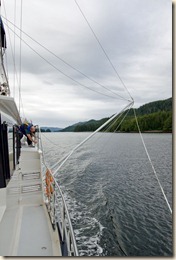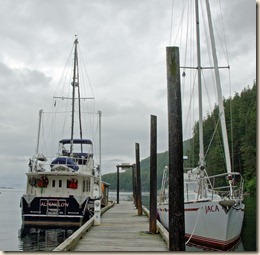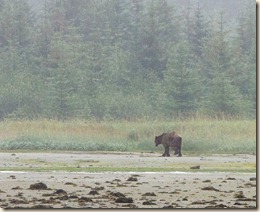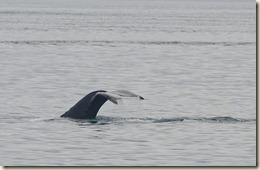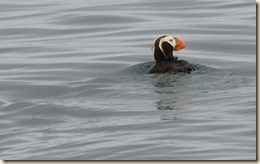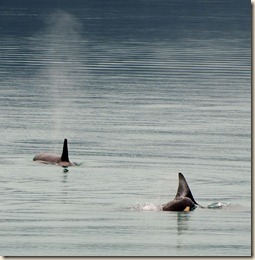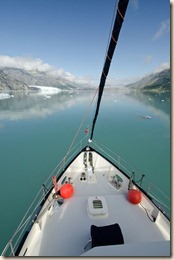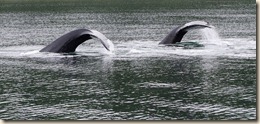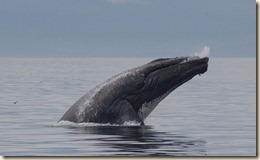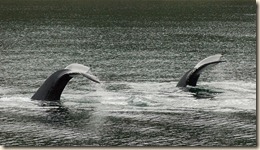I’ve been using pretty bland blog post titles so as to not to detract from the more journal style entries I am doing this year. The weather we’ve experienced recently its impact on our itinerary and schedule cannot be ignored, though.
After our friends, Sharon & Craig Rowley departed on August 11, we busily reprovisioned at Costco and Safeway for our trip south. Our intent was to head south through Wrangell Narrows and head into the town of Craig on the west side of Prince of Wales Island. From there we’d revisit Cordova Bay, round Cape Chacon at the tip of Prince of Wales Island and then head across to Prince Rupert, B.C., to clear into Canada.
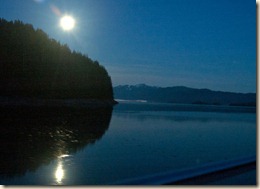 The next day, August 12, after adding 200 gallons of fuel to serve as our reserve for the trip home (we’ll do a total refuel when back in Puget Sound), we headed out. The weather kept improving as the day wore on and by the time we pulled into Tracy Arm Cove the clouds were breaking up. We even had a lovely full moon over the mountain towards our south.
The next day, August 12, after adding 200 gallons of fuel to serve as our reserve for the trip home (we’ll do a total refuel when back in Puget Sound), we headed out. The weather kept improving as the day wore on and by the time we pulled into Tracy Arm Cove the clouds were breaking up. We even had a lovely full moon over the mountain towards our south.
The weather remained good on Saturday, August 13, as we went to Cannery Cove, although the crossing was lumpy on account of the interaction between the brisk wind and current in Stephens Passage. We launched the dinghy, set two crab pots and went on the hunt for halibut in Pybus Bay. As we made our way between a couple of islands into the main bay, that same wind and current interaction occurred again. Since we were in the dinghy and not wanting to deal with much if any chop, we beat a retreat and Marcia tried her luck in more protected waters. No luck though. Back at the boat, though, we did catch a glimpse of a brown bear sow with three offspring.
Before we left on August 14, we retrieved the crab pots placed the afternoon before and managed two keeper crabs. Since the weather forecast was for a storm the next day, we decided to try an anchorage that offered good protection, a sticky bottom for the anchor and lots of swinging room for the boat in case we needed to hunker down. As it turned out, Portage Bay on the northend of Kuprenof Island only provided the last two items.
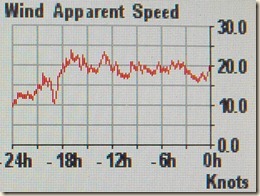 During the morning of August 15, the weather deteriorated as was forecast. The five other boats in the anchorage the night before all cleared out as the morning wore on. We stayed put assuming that while we might have some fetch bringing wave chop as was mentioned in the guide book, it wouldn’t be too bad. The wind started in the 15 to 25 knot range but picked up to 20 to 30 knots.
During the morning of August 15, the weather deteriorated as was forecast. The five other boats in the anchorage the night before all cleared out as the morning wore on. We stayed put assuming that while we might have some fetch bringing wave chop as was mentioned in the guide book, it wouldn’t be too bad. The wind started in the 15 to 25 knot range but picked up to 20 to 30 knots.
What really made it unpleasant was the current that swept past our boat depending on whether the tide was rising or falling. When the tide rose, the wind and current were fighting each other causing the wind driven waves to steepen and become closer together. Additionally, current was strong enough that it pushed the boat upwind. Our boat was the little stuffed animal being pulled (pushed in this case) apart by two children. The worse moments were when we had 3-foot choppy waves hitting the boat broadside because the current was pushing us one way while the wind was pushing us the opposite.
As the tide changed and the current with it, the battle was over and they both pulled us hard against our anchor. Fortunately the bottom was good and the anchor well set. Since everybody else had bailed that anchorage we certainly didn’t worry about swinging into anyone.
The next day, August 16, was a little bit better but not so good that we wanted to head out and fight conditions to either a new anchorage or uncertain docking in Petersburg. We stayed another night in our private purgatory.
At last, on August 17, the weather was much improved and we headed out on a rising tide (did I mention that the entrance to our anchorage was shallow with a dog-leg turn and had a propensity for fast current during tide changes?). We passed Petersburg and went straight in to Wrangell Narrows. This was our first southbound trip through the narrows and it looked different. Fortunately, we are gaining confidence and while we remain very attentive we aren’t stressed the way were on our first transit through Wrangell Narrows. We made for the very convenient anchorage in St John Harbor, just four miles south of the south entrance to Wrangell Narrows.
The next morning, August 18, we decided to do as many miles as we could since the forecast was for another storm to come through in a couple of days. The ultimate destination kept changing as we rode a favorable current out of Sumner Strait. We ended up the day at Kaguk Cove, an anchorage east of Sea Otter Sound and only 27 miles from Craig, what we intended to be our last town visited before heading into British Columbia.
With the early forecast on Friday, August 19, we knew we needed to get to Craig as quickly and as soon as we could since gale force winds were forecast that evening. Rain showers were already starting but the winds were still in the teens until we started to head into more open channels, then gusts in the upper 20’s began to buffet the boat. About the same time we picked up a radio transmission from a commercial fishing boat to the Craig Harbor Master. It sounded like everything was filled and the boats were beginning to raft up. At that point we were still 17 miles from Craig and decided to cut our losses and head back to anchorage that we knew was good. After a 20 mile trip to nowhere, we anchored again in Kaguk Cove to wait out the storm.
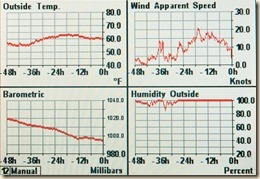 The winds picked up during the evening as forecast and continued into August 20. It rained a lot and we spent a lot of time trying to keep the interior windows from fogging up. We monitor some basic weather conditions with the instruments on the boat. What struck us was the dramatic pressure drop during the storm and the rapid temperature rise. The temperature rose during the night from the mid 50’s to the low 60’s. It felt like one of those “Pineapple Express” storms that Puget Sound gets during the winter where a tropical storm from the central Pacific comes barreling into the area.
The winds picked up during the evening as forecast and continued into August 20. It rained a lot and we spent a lot of time trying to keep the interior windows from fogging up. We monitor some basic weather conditions with the instruments on the boat. What struck us was the dramatic pressure drop during the storm and the rapid temperature rise. The temperature rose during the night from the mid 50’s to the low 60’s. It felt like one of those “Pineapple Express” storms that Puget Sound gets during the winter where a tropical storm from the central Pacific comes barreling into the area.
It was while waiting out this storm and listening to the upcoming weather that we decided that the weather pattern for Alaska had switched to a more autumnal mode and that the storms would be stronger and more frequent than seen in the summer. It was time to abandon every other goal except heading south. For us that meant heading north through (generally) more protected waters back down through Ketchikan and cross Dixon Entrance, the unavoidable open section of water separating Alaska and British Columbia, at the first weather window after positioning ourselves for the crossing.
On August 21, we motored north through El Capitan Passage out into Sumner Strait and headed for Hole-in-the-Wall on the northwest corner of Prince of Wales Island. I became enamored with the description of its entrance and protection as described in the guide book. While everything turned out fine, the entry was nerve wracking as I had to pass one submerged rock on the right then one on the left while ignoring the breaking waves from the following seas on either side of the entry. While the initial entry was as narrow, at one point further in, we concluded it was only 100’ wide. Ultimately, we had a lovely anchorage with very little wind and only a tiny bit of swell working its well through the entrance.
The next day, August 22, the exit from our anchorage was not nearly as stressful as the entry. We continued north around Point Baker, along Sumner Strait and south down Clarence Strait. The winds were forecast at 20 knots but we generally saw winds in the low teens instead. That is, until we turned the corner at Clarence Strait. At that point, winds are in the low 20’s and gusts to the upper 20’s. Since it was on the “nose”, it is more a nuisance than an issue. As we got into the more open sections of Clarence Strait, the pounding got worse but we persevered and pulled into Ratz Harbor for the night. It was a surprisingly protected and comfortable anchorage.
Once again the forecast was for gale force winds on the night of August 23. Until that time, the forecast was for SE 25 knots with 5 foot seas. We got a 0430 start in the dark (it is nearly the end of August after all!). Our goal is to tie up in Ketchikan by early afternoon. Things went well for the first 1-1/2 hours until we started into the central part of Clarence Strait. At this point we start pounding in very short duration 5 foot seas. The bow pitches up and then comes crashing down, nearly burying the anchor (8 feet above the water line) in the water. Fortunately there was a nearby bail out option and by 0815 we are tied up to the transient dock in Thorne Bay.
Later that day, we are joined on the dock by the sailing vessel Noah from Point Roberts Washington. It being the small world it is, we had gone through the Glacier Bay National Park boater orientation with them in early August. Its owners, a very nice couple, Kellie and Terry, concluded similarly to us that while, yes, the boat might be able to handle pounding like we experienced in Clarence Strait there was no reason to do it voluntarily. We spent a pleasant evening talking boats and plans.
Today, August 24, we remain at the dock planning on departing tomorrow in forecasted SE 10 knots with 2-foot seas. We will take advantage of those conditions and go as far as we can get. Hopefully we will be in Prince Rupert, BC this weekend.
Distance covered in this leg (including our “sightseeing” trip of about 20 miles) is 404.3 bringing the total distance traveled to 2585.3 nautical miles.



